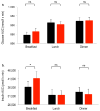Sleep restriction increases free fatty acids in healthy men
- PMID: 25702040
- PMCID: PMC4358810
- DOI: 10.1007/s00125-015-3500-4
Sleep restriction increases free fatty acids in healthy men
Abstract
Aims/hypothesis: Sleep loss is associated with insulin resistance and an increased risk for type 2 diabetes, yet underlying mechanisms are not understood. Elevation of circulating non-esterified (i.e. free) fatty acid (NEFA) concentrations can lead to insulin resistance and plays a central role in the development of metabolic diseases. Circulating NEFA in healthy individuals shows a marked diurnal variation with maximum levels occurring at night, yet the impact of sleep loss on NEFA levels across the 24 h cycle remains unknown. We hypothesised that sleep restriction would alter hormones that are known to stimulate lipolysis and lead to an increase in NEFA levels.
Methods: We studied 19 healthy young men under controlled laboratory conditions with four consecutive nights of 8.5 h in bed (normal sleep) and 4.5 h in bed (sleep restriction) in randomised order. The 24 h blood profiles of NEFA, growth hormone (GH), noradrenaline (norepinephrine), cortisol, glucose and insulin were simultaneously assessed. Insulin sensitivity was estimated by a frequently sampled intravenous glucose tolerance test.
Results: Sleep restriction relative to normal sleep resulted in increased NEFA levels during the nocturnal and early-morning hours. The elevation in NEFA was related to prolonged nocturnal GH secretion and higher early-morning noradrenaline levels. Insulin sensitivity was decreased after sleep restriction and the reduction in insulin sensitivity was correlated with the increase in nocturnal NEFA levels.
Conclusions/interpretation: Sleep restriction in healthy men results in increased nocturnal and early-morning NEFA levels, which may partly contribute to insulin resistance and the elevated diabetes risk associated with sleep loss.
Conflict of interest statement
The authors declare that there is no duality of interest associated with this manuscript.
Figures





Comment in
-
Are we waking up to the effects of NEFA?Diabetologia. 2015 Apr;58(4):651-3. doi: 10.1007/s00125-014-3489-0. Epub 2015 Jan 25. Diabetologia. 2015. PMID: 25617999 Free PMC article.
References
-
- Spiegel K, Leproult R, van Cauter E. Impact of sleep debt on metabolic and endocrine function. Lancet. 1999;354:1435–1439. - PubMed
-
- Spiegel K, Knutson K, Leproult R, Tasali E, van Cauter E. Sleep loss: a novel risk factor for insulin resistance and type 2 diabetes. J Appl Physiol. 2005;99:2008–2019. - PubMed
Publication types
MeSH terms
Substances
Grants and funding
- UL1 TR000430/TR/NCATS NIH HHS/United States
- P60-DK20595/DK/NIDDK NIH HHS/United States
- P50-HD057796/HD/NICHD NIH HHS/United States
- P30 DK020595/DK/NIDDK NIH HHS/United States
- R01-HL-075079/HL/NHLBI NIH HHS/United States
- R01 HL086459/HL/NHLBI NIH HHS/United States
- P01-AG11412/AG/NIA NIH HHS/United States
- CTSA-UL1 TR000430/TR/NCATS NIH HHS/United States
- P50 HD057796/HD/NICHD NIH HHS/United States
- R01 HL075079/HL/NHLBI NIH HHS/United States
- T32 HL007909/HL/NHLBI NIH HHS/United States
- P41 RR013642/RR/NCRR NIH HHS/United States
- P60 DK020595/DK/NIDDK NIH HHS/United States
- P01 AG011412/AG/NIA NIH HHS/United States
LinkOut - more resources
Full Text Sources
Other Literature Sources

